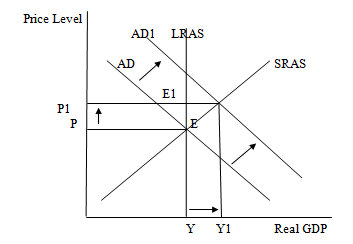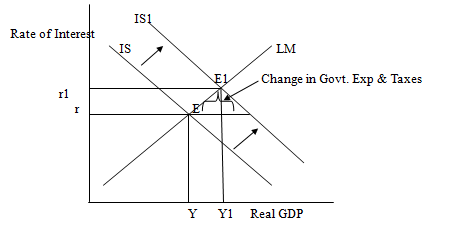
a.The level of change in real
b. The level of change in real government spending and real taxes over the four most recent quarters of data available and the four quarters prior to that.
c. Provide the explanation to answer part a and part b using the IS and AD curves
Explanation of Solution
a. Real GDP: Real Gross Domestic Product
Real Government Expenditure: Real Government Spending
PCE: Personal Consumption Expenditure
[of a quarter of current year w.r.t to the prior quarter of previous year]
b.
[of a quarter of current year w.r.t to the prior quarter of previous year]
[of a quarter of current year w.r.t to the prior quarter of previous year]
| Year
Quarter Month | Real Govt. Spending | Change In Levels of Govt. Spend. | Level of Change in Real Govt Spend % | Real GDP | Change in Levels of GDP | Level of Change in Real GDP % | Federal Govt. Current Taxes Receipts | PCE | Real Taxes =Taxes/PCE * 100 | Level of Change in Real Taxes | Level of Change in Real Taxes % | ||
| 2016 Q1 Jan | 2903.1 | 16571.5 | 2060 | 109.9 | 1874.43 | ||||||||
| 2016 Q2 apr | 2896.3 | 16663.5 | 2096.2 | 110.5 | 1897.01 | ||||||||
| 2016 Q3 July | 2899.9 | 16778.1 | 2131.5 | 111 | 1920.27 | ||||||||
| 2016 Q4 oct | 2901.1 | 16851.4 | 2112.9 | 111.5 | 1894.98 | ||||||||
| 2017 Q1 jan | 2896.6 | -6.5 | -0.22 | 16903.2 | 331.7 | 2.00 | 2133.3 | 112.1 | 1903.03 | 28.60 | 1.53 | ||
| 2017 Q2 apr | 2895.2 | -1.1 | -0.04 | 17031 | 367.5 | 2.21 | 2150.6 | 112.2 | 1916.76 | 19.74 | 1.04 | ||
| 2017 Q3 july | 2899.9 | 0 | 0.00 | 17163.8 | 385.7 | 2.30 | 2176.7 | 112.6 | 1933.13 | 12.86 | 0.67 | ||
| 2017 Q4 oct | 2921.5 | 20.4 | 0.70 | 17286.4 | 435 | 2.58 | No data | 113.4 | No data | No data | No data |
*St. Louis Reserve Fred Database
Interpretation: Findings -
- Real Government Spending is increasing
- Real GDP is increasing
- Real Taxes are reducing
b. Graphs:
Fig1: Effect of Changes in Government Spending & Taxes On Shifts on Aggregate

Short Run Upward moving
Fig2: Effect of Changes in Government Spending & Taxes On Shifts in IS Curve [Investment Saving Curve]

Short run equilibrium is attained between interest rates and output when IS intersects LM curves at point E. Here, Gross domestic product (GDP), or (Y), is placed on the horizontal axis, increasing as it stretches to the right. The nominal interest rate, or (i or R), makes up the vertical axis. If there is an increase in real government spending then the IS curve would shift to the right. ie. when the government spending goes up [when G goes up] it would shift the IS curve to the right and a new equilibrium is achieved at point E1. In the same way, reduction in taxes also causes the IS curve to shift rightward leading to new equilibrium rate of interest and real GDP. This causes an increase in the rate of interest and real GDP as found in the above table.
Introduction:
AD [Aggregate Demand] curve represents the relationship between the inflation rate &
The IS-LM model, which stands for "investment-savings, liquidity-money," is a Keynesian
Want to see more full solutions like this?
Chapter 23 Solutions
MYLAB ECONOMICS WITH PEARSON ETEXT -- A
- A decrease in money demand causes the real interest rate to _____ and output to _____ in the short run, before prices adjust to restore equilibrium. Group of answer choices rise; rise fall; fall fall; rise rise; fallarrow_forwardIf a country's policy makers were to continously use expansionary monetary policy in an attempt to hold unemployment below the natural rate , the long urn result would be? Group of answer choices a decrease in the unemployment rate an increase in the level of output All of these an increase in the rate of inflationarrow_forwardA shift in the Aggregate Supply curve to the right will result in a move to a point that is southwest of where the economy is currently at. Group of answer choices True Falsearrow_forward
- An oil shock can cause stagflation, a period of higher inflation and higher unemployment. When this happens, the economy moves to a point to the northeast of where it currently is. After the economy has moved to the northeast, the Federal Reserve can reduce that inflation without having to worry about causing more unemployment. Group of answer choices True Falsearrow_forwardThe long-run Phillips Curve is vertical which indicates Group of answer choices that in the long-run, there is no tradeoff between inflation and unemployment. that in the long-run, there is no tradeoff between inflation and the price level. None of these that in the long-run, the economy returns to a 4 percent level of inflation.arrow_forwardSuppose the exchange rate between the British pound and the U.S. dollar is £1 = $2.00. The U.S. government implementsU.S. government implements a contractionary fiscal policya contractionary fiscal policy. Illustrate the impact of this change in the market for pounds. 1.) Using the line drawing tool, draw and label a new demand line. 2.) Using the line drawing tool, draw and label a new supply line. Note: Carefully follow the instructions above and only draw the required objects.arrow_forward
- Just Part D please, this is for environmental economicsarrow_forward3. Consider a single firm that manufactures chemicals and generates pollution through its emissions E. Researchers have estimated the MDF and MAC curves for the emissions to be the following: MDF = 4E and MAC = 125 – E Policymakers have decided to implement an emissions tax to control pollution. They are aware that a constant per-unit tax of $100 is an efficient policy. Yet they are also aware that this policy is not politically feasible because of the large tax burden it places on the firm. As a result, policymakers propose a two- part tax: a per unit tax of $75 for the first 15 units of emissions an increase in the per unit tax to $100 for all further units of emissions With an emissions tax, what is the general condition that determines how much pollution the regulated party will emit? What is the efficient level of emissions given the above MDF and MAC curves? What are the firm's total tax payments under the constant $100 per-unit tax? What is the firm's total cost of compliance…arrow_forward2. Answer the following questions as they relate to a fishery: Why is the maximum sustainable yield not necessarily the optimal sustainable yield? Does the same intuition apply to Nathaniel's decision of when to cut his trees? What condition will hold at the equilibrium level of fishing in an open-access fishery? Use a graph to explain your answer, and show the level of fishing effort. Would this same condition hold if there was only one boat in the fishery? If not, what condition will hold, and why is it different? Use the same graph to show the single boat's level of effort. Suppose you are given authority to solve the open-access problem in the fishery. What is the key problem that you must address with your policy?arrow_forward
- 1. Repeated rounds of negotiation exacerbate the incentive to free-ride that exists for nations considering the ratification of international environmental agreements.arrow_forwardFor environmental Economics, A-C Pleasearrow_forwardTrue/ False/ Undetermined - Environmental Economics 3. When the MAC is known but there is uncertainty about the MDF, an emissions quota leads to a lower deadweight loss associated with this uncertainty.arrow_forward

 Principles of Economics (12th Edition)EconomicsISBN:9780134078779Author:Karl E. Case, Ray C. Fair, Sharon E. OsterPublisher:PEARSON
Principles of Economics (12th Edition)EconomicsISBN:9780134078779Author:Karl E. Case, Ray C. Fair, Sharon E. OsterPublisher:PEARSON Engineering Economy (17th Edition)EconomicsISBN:9780134870069Author:William G. Sullivan, Elin M. Wicks, C. Patrick KoellingPublisher:PEARSON
Engineering Economy (17th Edition)EconomicsISBN:9780134870069Author:William G. Sullivan, Elin M. Wicks, C. Patrick KoellingPublisher:PEARSON Principles of Economics (MindTap Course List)EconomicsISBN:9781305585126Author:N. Gregory MankiwPublisher:Cengage Learning
Principles of Economics (MindTap Course List)EconomicsISBN:9781305585126Author:N. Gregory MankiwPublisher:Cengage Learning Managerial Economics: A Problem Solving ApproachEconomicsISBN:9781337106665Author:Luke M. Froeb, Brian T. McCann, Michael R. Ward, Mike ShorPublisher:Cengage Learning
Managerial Economics: A Problem Solving ApproachEconomicsISBN:9781337106665Author:Luke M. Froeb, Brian T. McCann, Michael R. Ward, Mike ShorPublisher:Cengage Learning Managerial Economics & Business Strategy (Mcgraw-...EconomicsISBN:9781259290619Author:Michael Baye, Jeff PrincePublisher:McGraw-Hill Education
Managerial Economics & Business Strategy (Mcgraw-...EconomicsISBN:9781259290619Author:Michael Baye, Jeff PrincePublisher:McGraw-Hill Education





